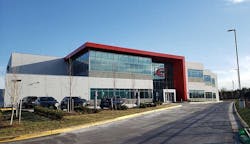QTS Builds for a Future Filled With Faster, Larger Hyperscale Projects
ASHBURN – As you drive up the ramp from the Dulles Greenway onto Loudoun County Parkway, there’s a new presence that fills your field of vision. It’s the red-and-white facade of a QTS data center, positioned at the gateway to Northern Virginia’s Data Center Alley.
For QTS Data Centers, the visual prominence of the Shellhorn-DC1 building tracks with the company’s emergence as a leading player in hyperscale infrastructure. The QTS growth story has been powered by two prevailing trends: the growth of hyperscale computing and the consolidation in the data center sector.
It’s been just four years since QTS overhauled its business to focus on the hyperscale market, shedding a managed services business and in-house cloud offering. Backed by the financial strength of Blackstone, which acquired QTS last year for $10 billion, the company is now competing for – and winning – some of the largest hyperscale deals.
As a private company, QTS no longer issues public updates on its performance. But third-party reporting has highlighted the company’s success in Hillsboro, Oregon, where it is supporting a large new data center campus for Meta. A regulatory filing reveals that QTS and utility PGE are seeking 250 megawatts (MW) of renewable energy capacity to support the multi-building Meta project.
While the precise details of the Meta deal are not public, it is without a doubt one of history’s largest wholesale data center deals.
QTS has also seen leasing success in Ashburn, where demand from large customers has helped populate the 42-megawatt Shellhorn-DC1 data center, and prompted the construction of an identical facility next to it.
The project displays the company’s ability to deliver capacity quickly, as QTS was able to transform the site from dirt to a fully-commissioned data center in seven months during one of the toughest periods of the COVID-19 pandemic.
Speed Matters for Hyperscale Builds
The 310,000 square foot Shellhorn DC-1 was cited as Data Center Construction Project of the Year in the Northern Virginia Technology Council’s 2021 Data Center Awards.
“QTS has rapidly established itself as a leader in the Ashburn data center development community,” said Buddy Rizer, Executive Director, Loudoun County Department of Economic Development. “We welcome its economic contributions and appreciate the partnership with county staff that allowed them to create the new state-of-the-art Ashburn-Shellhorn data center that is the fastest ever data center built in Northern Virginia.”
Power and cooling equipment in a gallery running alongside a data hall in the QTS Shellhorn DC-1 data center. (Photo: Rich Miller)
There have been other projects in the region that have been deployed quickly – notably the CyrusOne Sterling II project, which was built in 6 months in 2016 – but few have faced the challenges confronted by QTS in 2020. The Shellhorn project was part of a building boom in Loudoun County as hyperscale providers raced to provision capacity to meet intense demand for cloud services as COVID-19 precautions shifted school, work and entertainment to an online delivery model.
The Shellhorn project is one of the first data centers delivered using the QTS Freedom Building Design, which was created to combine a standard design with smart logistics. QTS says the design helps it deliver data centers faster, while remaining flexible enough to adapt to the requirements of hyperscale and cloud operators, who now account for more than 50% of the company’s business.
The QTS Journey: Retrofits to Hyperscale
QTS was founded in 2005 by Chad Williams as Quality Technology Services, operating a single data center in Kansas. Williams continues to serve as Chairman and Chief Executive Office of QTS, but the company now operates more than 7 million square feet of data centers in in 20 markets across North America and Europe, including large data center campuses in Northern Virginia, Chicago, Dallas, Atlanta and Oregon.
In its early years, the company was known for retrofits of mega-scale industrial facilities to create large data centers. In 2018 QTS shifted its development focus to the largest customers in the hyperscale market, a move that coincided with the opening of the company’s first facility in Ashburn, the leading market for cloud infrastructure.
That strategy was gaining momentum at the onset of the pandemic, which prompted more customers to embrace the remote management tools in the QTS Service Delivery Platform (SDP), which provides customers easy access to more cameras, sensors and KVM (keyboard, video, mouse) management tools. This allowed QTS to offer customers options while restricting their access to facilities.
The success of SDP is among the factors that impressed Blackstone, the world’s largest alternative asset manager, as it sought to invest in digital infrastructure. .
“QTS aligns with one of Blackstone’s highest conviction themes – data proliferation – and the required investment makes it well suited as a long-term holding for our perpetual capital vehicles,” said Greg Blank and Tyler Henritze, Senior Managing Directors at Blackstone.
Why The Freedom Design Matters
QTS broke ground on the Shellhorn project on June 1, 2020, and completed the space with fully-commissioned power in place on Dec. 31. The company says the shift to the Freedom Design was key in accelerating its delivery. The design was a response to the speed of hyperscale expansions, and brought together the design and logistics teams to streamline their processes and timelines.
“It’s a flexible setup that works with interchangeable vendors,” said James RePass, the Vice President of Facilities Operations at QTS. “It allows us to drive to a custom solution within a standard product.”
The design employs an N+1 approach to power infrastructure, featuring power pods that include a 1.5-megawatt UPS and switchgear, backed by a 2.25-megawatt generator. Standardizing the design enabled QTS to build its UPS rooms offsite in a factory in Louisiana, where the production line can operate continuously and direct finished pods to each new project as needed.
The equipment yard of QTS Shellhorn DC-1, filled with power pod infrastructure, with a view of the frame for the next 42-megawatt data center planned for the campus. (Photo: Rich Miller)
Thirty two of these pods are deployed along the length of the Shellhorn facility, supporting a flexible design for the 170,000 square feet of data halls inside the building, which can be configured to be as large as 10.5 megawatts.
“You can right-size deployments from the start,” said RePass. “The underlying base design allows almost anything the customer wants to do, even with high-density air cooling.”
The Road Ahead: Competing at Scale
The Freedom design is also being used in Hillsboro to deliver the massive campus for Meta. It’s one of the first major deals since the completion of the Blackstone acquisition in August 2021, which set off a ripple effect of data center M&A, and may serve as a prototype for how investors can accelerate the growth of privately-held data center developers.
Blackstone is among the large investors focused on the data center industry and the growth of the digital economy. With more than $684 billion in assets under management, Blackstone provides QTS with extraordinary resources to fund data center construction and management technology, a network of potential partners and customers across Blackstone’s investment universe.
The placement of QTS within Blackstone’s perpetual funds is strategically important, as these funds focus on long-term holdings, unlike targeted funds that typically seek returns within a specific timeframe. That matters in cloud computing, where tenants want development runway for long-term growth. Blackstone’s backing means QTS can pursue the land and construction financing to make that happen.
Blackstone’s backing means QTS can pursue the land and construction financing to create long-term runways for data center growth.
Northern Virginia is an example. QTS has room to grow on its campuses in Ashburn and Manassas, but is also looking to secure up to 800 acres of land in Prince William County as part of the Digital Gateway project, which would create a massive data center district near one of the area’s Civil War battlefields. QTS has not publicly discussed the details of its proposal, but says it will pursue “a thoughtful development strategy that will preserve the historical significance and aesthetic beauty of the area.”
QTS is also building a connectivity strategy to enable a shift away from traditional data hubs in major markets, as cloud players seek favorable economics and room for long-term growth for network infrastructure. Amazon Web Services recently deployed components of its network infrastructure in QTS data centers in Chicago, Atlanta, and Piscataway, N.J.
The AWS regional deployments align with the QTS’ ambitions to decentralize network architecture, moving beyond the traditional interconnection model. in which network hubs in the central business district large of major cities are the center of gravity for interconnection.
Sean Baillie, Executive Vice President, Connectivity at QTS, says that growing clouds need more equipment space than is easily available in carrier hotels, which are often downtown towers with limited floor plates.
“I think that this is a validator that we’re on the right track,” said Baillie. “This is going to change the nature of big network exchanges in major US markets.”
The markets for hyperscale computing and interconnection services remain intensely competitive. With an experienced team, streamlined design and strong financial backing, QTS has navigated the fast-moving trends shaping digital infrastructure, positioning itself to be a bigger builder of the clouds to come.






